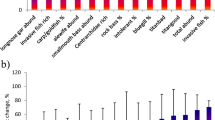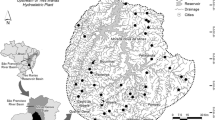Abstract
Replication is usually regarded as an integral part of biological sampling, yet the cost of extensive within-wetland replication prohibits its use in broad-scale monitoring of trends in aquatic invertebrate biodiversity. In this paper, we report results of testing an alternative protocol, whereby only two samples are collected from a wetland per monitoring event and then analysed using ordination to detect any changes in invertebrate biodiversity over time. Simulated data suggested ordination of combined data from the two samples would detect 20% species turnover and be a cost-effective method of monitoring changes in biodiversity, whereas power analyses showed about 10 samples were required to detect 20% change in species richness using ANOVA. Errors will be higher if years with extreme climatic events (e.g. drought), which often have dramatic short-term effects on invertebrate communities, are included in analyses. We also suggest that protocols for monitoring aquatic invertebrate biodiversity should include microinvertebrates. Almost half the species collected from the wetlands in this study were microinvertebrates and their biodiversity was poorly predicted by macroinvertebrate data.
Similar content being viewed by others
References
Anderson DR, Link WA, Johnson DH and Burnham KP (2001) Suggestions for presenting the results of data analyses. J Wildl Manage 65: 373-378
Andrew NL and Mapstone BD (1987) Sampling and the description of spatial pattern in marine ecology. Oceanogr Mar Biol Ann Rev 25: 39-90
Azarbayjani FF and Richardson BJ (1999) Monitoring for changes in aboreal arthropod biodiversity in woodlands: how many replicates are needed? In: Ponder W and Lunney D (eds.), The Other 99%: The Conservation and Biodiversity of Invertebrates. Transactions of the Zoological Society of New South Wales, Sydney, pp. 40-45
Barbault R and Sastrapradja SD (1995) Generation, maintenance and loss of biodiversity. In: Heywood VV and Watson RT (eds) Global Biodiversity Assessment. Cambridge University Press, Cambridge, pp. 193-274
Bureau of Statistics (1995) Western Australian Yearbook. Australian Bureau of Statistics, Perth
Belbin L (1993) PATN: Pattern Analysis Package. CSIRO, Canberra
Butcher RJ (1999) Assessing biodiversity in temporary and permanent wetlands. In: Ponder W and Lunney D (eds.), The Other 99%: The Conservation and Biodiversity of Invertebrates. Transactions of the Zoological Society of New South Wales, Sydney, pp. 50-53
Cheal F, Davis JA, Growns JE, Bradley J.S. and Whittles FH (1993) The influence of sampling method on the classification of wetland macroinvertebrate communities. Hydrobiologia 257: 47-56
Clark KR and Green RH (1988) Statistical design and analysis for a ‘biological effects’ study. Mar Ecol Prog Ser 46: 213-226
Clarke RT, Furse MT, Wright JF and Moss D (1996) Derivation of a biological quality index for river sites: comparison of the observed with the expected fauna. J Appl Stat 23: 311-332
Dole-Olivier M-J, Galassi DMP, Marmonier P and Creuzé des Chatelliers, M (2000) The biology and ecology of lotic microcrustaceans. Freshwat Biol 44: 63-91
Edward DH, Storey AW and Smith MJB (2001) Assessing river health in south-western Australia: comparison of macroinvertebrates at family level with Chironomidae at species level. Verh Int Ver Limnol 27: 2326-2335
Fairweather PG (1991) Statistical power and design requirements for environmental monitoring. Aust JMar Freshwat Res 42: 555-567
Faith DP, Dostine PL and Humphrey CL (1995) Detection of mining impacts on aquatic macroinvertebrate communities: results of a disturbance experiment and the design of a multivariate BACIP monitoring programme at Coronation Hill, Northern Territory. Aust J Ecol 20: 167-180
Froend RH, Halse SA and Storey AW (1997) Planning for the recovery of Lake Toolibin, Western Australia. Wetl Ecol Manage 5: 73-85
Gentilli J (1972) Australian Climate Patterns. Nelson, Melbourne
George RJ, McFarlane DJ and Speed RJ (1995) The consequences of a changing hydrologic environment for native vegetation in south-western Australia. In: Saunders DA, Craig JL and Mattiske EM (eds) Nature Conservation 4: The Role of Networks. Surrey Beatty, Sydney, pp. 9-22
Gray JS, Clarke KR, Warwick RM and Hobbs G (1990) Detection of initial effects of pollution on marine benthos: an example from the Ekofisk and Eldfisk oilfields, North Sea. Mar Ecol Prog Ser 66: 285-299
Green RH (1979) Sampling Design and Statistical Methods for Environmental Biologists. Wiley, New York
Growns JE, Davis JA, Cheal F, Schmidt LG, Rosich RS and Bradley JS (1992) Multivariate pattern analysis of wetland invertebrate communities and environmental variables in Western Australia. Aust J Ecol 17: 275-288
Hails AJ (ed.) (1996) Wetlands, Biodiversity and the Ramsar Convention. Ramsar Convention Bureau, Gland
Halse SA, Pearson GB and Patrick S (1993a) Vegetation of depth-gauged wetlands in nature reserves of south-west Western Australia. Tech Rep 30. Department of Conservation and Land Management, Perth
Halse SA, Pearson GB, McRae JM and Shiel RJ (2000a) Monitoring aquatic invertebrates and waterbirds at Toolibin and Walbyring Lakes in the Western Australian wheatbelt. J Roy Soc West Aust 83: 23-34
Halse SA, Shiel RJ, Storey AW, Edward DHD, Lansbury I, Cale DJ and Harvey MS (2000b) Aquatic invertebrates and waterbirds of wetlands and rivers of the southern Carnarvon Basin, Western Australia. Rec West Aust Mus Suppl 61: 217-265
Halse SA, Shiel RJ and Williams WD (1998) Aquatic invertebrates of Lake Gregory, north-western Australia, in relation to salinity and ionic composition. Hydrobiologia 381: 15-29
Halse SA, Williams MR, Jaensch RP and Lane JAK (1993b) Wetland characteristics and waterbird use of wetlands in southwestern Australia. Wildl Res 20: 103-126
Humphrey CL, Faith DP and Dostine PL (1995) Baseline requirements for assessment of mining impact using biological monitoring. Aust J Ecol 20: 150-166
Karakassis I (1995) S8: a new method for calculating macrobenthic species richness. Mar Ecol Prog Ser 120: 299-303
Kay WR, Smith MJ, Pinder AM, McRae JM, Davis JA and Halse SA (1999) Patterns of distribution of macroinvertebrate families in rivers of north-western Australia. Freshwat Biol 41: 299-316
Kneib RT (1991) Flume weir for quantitative collection of nekton from vegetated intertidal habitats. Mar Ecol Prog Ser 75: 29-38
Moreno CE and Halffter G (2000) Assessing the completeness of bat biodiversity inventories using species accumulation curves. J Appl Ecol 37: 149-158
Ricciardi A and Rasmussen JB (1999) Extinction rates of North American freshwater fauna. Cons Biol 13: 1220-1222
Resh VH and McElravy EP (1993) Contemporary quantitative approaches to biomonitoring using benthic macroinvertebrates. In: Rosenberg DM and Resh VH (eds) Freshwater Biomonitoring and Benthic Macroinvertebrates. Chapman and Hall, New York, pp. 159-194
Rouch, R and Danielopol DL (1997) Species richness of microcrustacea in subterranean freshwater habitats, comparative analysis and approximate evaluation. Int Rev Ges Hydrobiol 82: 121-145
SAS Institute (1990) SAS/STAT User's Guide. SAS Institute Inc, Cary, NC
Savage JM (1995) Systematics and the biodiversity crisis. Bioscience 45: 673-679
Snedecor GW and Cochran WG (1980) Statistical Methods. Iowa State University Press, Ames, Iowa
Streever WJ (1998) Preliminary example of a sampling design assessment method for biomonitoring studies that rely on ordination. In: McComb AJ and Davis JA (eds) Wetlands for the Future: Contributions from INTECOL's 6th International Wetland Conference. Gleneagles Publishing, Adelaide, pp. 537-552
Timms BV (1981) Animal communities in three Victorian lakes of differing salinity. Hydrobiologia 81: 181-193
Timms BV (1998) Further studies on the saline lakes of the eastern Paroo, inland New South Wales, Australia. Hydrobiologia 381: 31-42
Turner AM and Trexler JC (1997) Sampling aquatic invertebrates from marshes: evaluating the options. J N Am Benthol Soc 16: 694-709
Underwood AJ (1993) The mechanics of spatially replicated sampling programmes to detect environmental impacts in a variable world. Aust J Ecol 18: 99-116
Usseglio-Polatera P, Bournard M, Richoux P and Tachet H (2000) Biological and ecological traits of benthic freshwater macroinvertebrates: relationships and definition of groups with similar traits. Freshwat Biol 43: 175-205.
Warwick RM (1993) Environmental impact studies on marine communities: pragmatical considerations. Aust J Ecol 18: 63-80
Williams WD (1999) Salinisation: major threat to water resources in the arid and semi-arid regions of the world. Lakes Reservoirs: Res Manage 4: 85-91
Author information
Authors and Affiliations
Rights and permissions
About this article
Cite this article
Halse, S., Cale, D., Jasinska, E. et al. Monitoring change in aquatic invertebrate biodiversity: sample size, faunal elements and analytical methods. Aquatic Ecology 36, 395–410 (2002). https://doi.org/10.1023/A:1016563001530
Issue Date:
DOI: https://doi.org/10.1023/A:1016563001530




